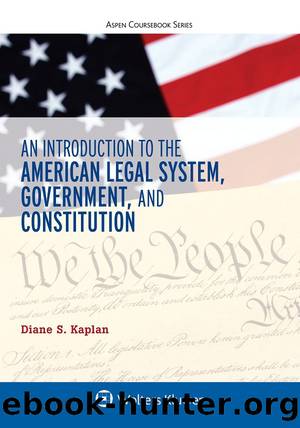An Introduction to the American Legal System, Government, and Constitutional Law (Aspen Coursebook Series) by Kaplan Diane S

Author:Kaplan, Diane S. [Kaplan, Diane S.]
Language: eng
Format: epub
Publisher: Wolters Kluwer Law & Business
Published: 2015-08-06T16:00:00+00:00
Justice Stevens filed the following dissent:
Justice Stevens, with whom Justice Souter and Justice Ginsburg join, dissenting.
On January 24, 2002, the Olympic Torch Relay gave those Alaska residents a rare chance to appear on national television. As Joseph Frederick repeatedly explained, he did not address the curious message—“BONG HiTS 4 JESUS”—to his fellow students. He just wanted to get the camera crews’ attention.…
I agree with the Court that the principal should not be held liable for pulling down Frederick’s banner. I would hold, however, that the school’s interest in protecting its students from exposure to speech “reasonably regarded as promoting illegal drug use,” cannot justify disciplining Frederick for his attempt to make an ambiguous statement to a television audience simply because it contained an oblique reference to drugs. The First Amendment demands more, indeed, much more.
The Court holds otherwise only after laboring to establish two uncontroversial propositions: first, that the constitutional rights of students in school settings are not coextensive with the rights of adults, and second, that deterring drug use by schoolchildren is a valid and terribly important interest. As to the first, I take the Court’s point that the message on Frederick’s banner is not necessarily protected speech, even though it unquestionably would have been had the banner been unfurled elsewhere. As to the second, I am willing to assume that the Court is correct that the pressing need to deter drug use supports [the school’s] rule prohibiting willful conduct that expressly “advocates the use of substances that are illegal to minors.” But it is a gross non sequitur to draw from these two unremarkable propositions the remarkable conclusion that the school may suppress student speech that was never meant to persuade anyone to do anything.
In my judgment, the First Amendment protects student speech if the message itself neither violates a permissible rule nor expressly advocates conduct that is illegal and harmful to students. This nonsense banner does neither, and the Court does serious violence to the First Amendment in upholding—indeed, lauding—a school’s decision to punish Frederick for expressing a view with which it disagreed.…
Two cardinal First Amendment principles animate…the Court’s opinion in Tinker …First, censorship based on the content of speech, particularly censorship that depends on the viewpoint of the speaker, is subject to the most rigorous burden of justification.…Second, punishing someone for advocating illegal conduct is constitutional only when the advocacy is likely to provoke the harm that the government seeks to avoid .
However necessary it may be to modify those principles in the school setting, Tinker affirmed their continuing vitality.…Yet today the Court fashions a test that trivializes the two cardinal principles upon which Tinker rests. The Court’s test invites stark viewpoint discrimination. In this case, for example, the principal has unabashedly acknowledged that she disciplined Frederick because she disagreed with the pro-drug viewpoint she ascribed to the message on the banner—a viewpoint, incidentally, that Frederick has disavowed.…[T]he Court’s holding in this case strikes at “the heart of the First Amendment” because it upholds a punishment
Download
This site does not store any files on its server. We only index and link to content provided by other sites. Please contact the content providers to delete copyright contents if any and email us, we'll remove relevant links or contents immediately.
| Elections & Political Process | Ideologies & Doctrines |
| International & World Politics | Political Science |
| Public Affairs & Policy | Specific Topics |
| United States |
The Secret History by Donna Tartt(18846)
The Social Justice Warrior Handbook by Lisa De Pasquale(12141)
Thirteen Reasons Why by Jay Asher(8796)
This Is How You Lose Her by Junot Diaz(6794)
Weapons of Math Destruction by Cathy O'Neil(6146)
Zero to One by Peter Thiel(5686)
Beartown by Fredrik Backman(5599)
The Myth of the Strong Leader by Archie Brown(5425)
The Fire Next Time by James Baldwin(5249)
How Democracies Die by Steven Levitsky & Daniel Ziblatt(5128)
Promise Me, Dad by Joe Biden(5087)
Stone's Rules by Roger Stone(5026)
A Higher Loyalty: Truth, Lies, and Leadership by James Comey(4845)
100 Deadly Skills by Clint Emerson(4840)
Rise and Kill First by Ronen Bergman(4704)
Secrecy World by Jake Bernstein(4646)
The David Icke Guide to the Global Conspiracy (and how to end it) by David Icke(4625)
The Farm by Tom Rob Smith(4437)
The Doomsday Machine by Daniel Ellsberg(4416)
